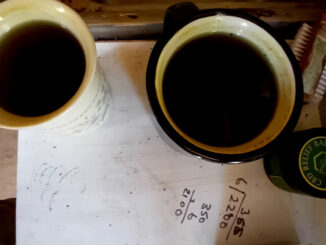
© Colin Cross, Going Postal 2022
I don’t know this for a fact, but I’m pretty sure whatever time you might choose to leave the environs of Delhi, unless it’s in the dead of night, the traffic on the main roads is going to be pretty busy. We were supposed to be leaving at 6.30am, but eventually got away just after 7. The ritual of tipping all the staff on duty at the time of departure, which we’d been forewarned about, is bound by loose but real parameters. I’d made the mistake of giving the door guy 100 rupees on my first trip to Haldirams, following which I’ve never had a door more professionally or courteously opened and closed for me in my life. I’d made it my business to make the senior desk clerk aware that I’d be doing the tipping for our two rooms, to save anyone any embarrassment and also to have plenty of 50 and 100 rupee notes to hand. It isn’t an expensive business, but you have to get it right, if you’ve given the door minder 100, you have to give the bell boys the same 100 and desk guys 200 each, there’s a hierarchy. 1,000 rupees poorer, but slightly wiser, we boarded our minibus for Jaipur and hit the noisy, bumpy, visually stirring and interesting road out.

© Colin Cross, Going Postal 2022
Although there are seven coins currently in circulation in India, from my experience there aren’t that many in regular use. A rupee is worth just a tad more than a UK pence, probably around 3d in real money, so we worked on a “one for one” basis as our rule of thumb. As we reached the outskirts of the city proper (although we’d be travelling through the growing urban sprawl of New Delhi for several more miles) we had to traverse a roundabout with an overpass. Gathered in the early morning shade were several hundred people, men, women and children and I enquired of our guide (I initially thought it was more Diwali celebrants) what they were up to. He explained they were day labourers, hoping to get get chosen for a day or more on a building site. Tuk Tuks were also in evidence, waiting to transport them to their labours. Several I saw had tools, some of the women and children had large, shallow woven baskets with them. I asked what the going rate was. Men, grown lads and adult women, without skills, could earn 550 rupees a day, with children maybe getting 300. A floor layer or decent painter could expect to be paid around 800. It’s a little better than the old 2 dollars a day story, but one has to wonder both how they manage and how the super wealthy rationalise it all. I did get to thinking about how some people perceive poverty and complain about how said perception of poverty affects them, I even get it, things are tough these days for many low earning workers, but, to be honest, until you see it close up (real poverty that is) you have no idea.
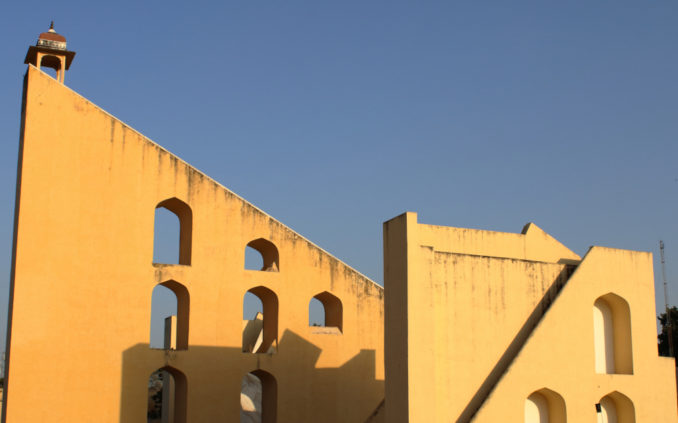
© Colin Cross, Going Postal 2022
We arrived in the city of Jaipur after some six hours on the road, we’d stopped for breakfast at an “hotel” (the Indian version of a motorway services) where I tasted my first Masala omelette, something which I became very familiar with. We travelled through farmland, scrub and fascinating bustling small urban areas. Cows and people are everywhere in these places and five “white” people passing through were as much of a curiosity to the local people as they were to us. I didn’t get a photo of several caged in banana stalls outside one small town, but the numbers of small monkeys patrolling between them, waiting for a handout from the stall holders, provided the reason for the need for said cages. We arrived at our Colonial style “boutique” hotel, The Arya Niwas in the early afternoon and just had time to put our bags in our rooms before heading out for some “culture”. The Jantar Mantar has to be one of the most fascinating places we visited on the whole trip, even given Jaipur itself is a sprawling and growing place, with a rich history and much to see. It’s walled Old City, complete with seven gates and an abundance of both Indian and Maghul architecture could take days to take in, if the time was available. Jantar Mantar is an observatory which was built by Sawai Jai Singh the Second, the founder of the city of Jaipur. It was completed in 1734 and is home to the worlds largest sundial. There are 19 astronomical instruments (if instrument is the right word) which allow the observation of astronomical positions by the naked eye. Our local guide was extremely knowledgeable but we also were given plenty of time to wander around on our own. As with everywhere we went in northern India, especially given the number of holidays they celebrate, there were people everywhere, but we never felt either overwhelmed or threatened in any way.
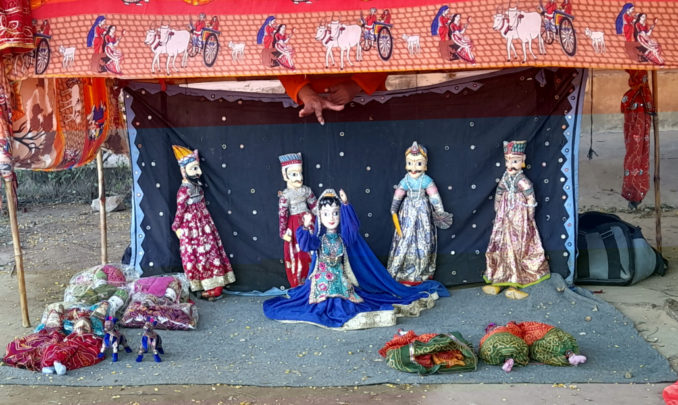
© Colin Cross, Going Postal 2022
There were a couple of puppet shows in the grounds of the observatory, a traditional entertainment, locally called Kathputli which dates back thousands of years and was originally the province of itinerant farm labourers called “Bhats” who supplemented their income by putting on shows, usually in the evenings when it became too dark to work in the fields. Imagine my surprise to find a certain Mr Schwab behind the curtain of one such show, manipulating a puppet of Jacinda Ardern under the intent and watchful gaze of faithful representations of those other famous WEF puppets, Rishi Sunak, Justin Trudeau, Guy Verhofstadt and Leo Varadkar. No doubt Klaus was taking the time our from his busy Davos schedule to introduce, not too subtly, the joys of Globalism to the Indian proletariat. Funnily enough, most of them seem to own very little already, as to whether or not they’re happy with their lot I couldn’t say with any certainty, but I’m guessing they won’t be going cashless any time soon. In India, cask is King. We left the observatory grounds and took a short drive, past a couple of the ornate gates previously mentioned, to visit the “floating” Pink Palace (Jal Mahal), another architectural wonder dating back to the late 17th century which was later extended and improved by the same Jai Singh I’ve previously mentioned. A Romantic and a man of great vision, as we were to continue to discover.

© Colin Cross, Going Postal 2022
Jaipur is home to several exponents of one of the oldest artisan crafts in India, direct ink block printing. In the factory we visited, after leaving the “Pink Palace” we were luckt to be able to see a craftsman at his painstaking work. All the blocks are first designed and then carved by hand onto pieces of Shesham wood. All the dyes are made from natural products and no man made fabrics are used. Although a “run” of a particular product may look much the same, each one is uniquely different being always hand printed. It takes years to learn to carve the stencils and a long time to skillfully apply the ink to the fabric at just the right consistency of colour and pressure of application. Products from this artisan business are now exported all over the world, but beware of often skillful imitations.
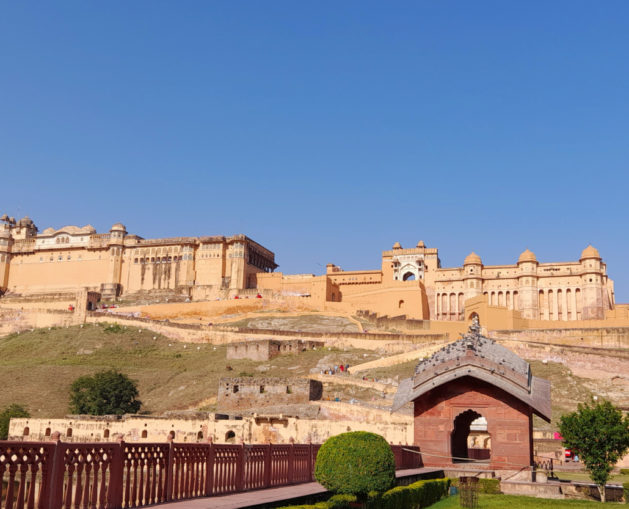
© Colin Cross, Going Postal 2022
The following morning was spent exploring the Amber Fort, also known as The Amer Palace, Amer being the original capital of Rajahstan, prior to its relocation to Jaipur in 1727 . Construction got under way some time in the mid 16th century, on the orders of Raja Man Singh who created a fortified palace of imposing architectural beauty and impregnability. It’d take me many words to talk you through the place, but there’s a wealth of information on line (if you’re interested). The residential area is built on four levels, each with its own courtyard; “The Hall Of Public Audience” (Diwan-e-Aam), “The Hall Of Private Audience” (Diwan-e-Khas) The Mirror Palace (Sheesh Mahal) comprise the three areas for court, state and public business all with stunning architectural and artistic merit. The natural weather patterns were used to both cool and warm the building and the gardens, although now given over to a hardy grass must have been stunning. Raja Man Singh had 12 queens, each one having her own living quarters on the same level, all accessible by a single staircase so he could visit any one of his choosing without the other s knowing. the women weren’t allowed to use the staircases but they had a communal area in the fourth courtyard (Sukh Niwas) where they could be entertained during the day by musicians, puppeteers and dancing girls and, no doubt, compare notes. There were concubines too, but how many is anyone’s guess.
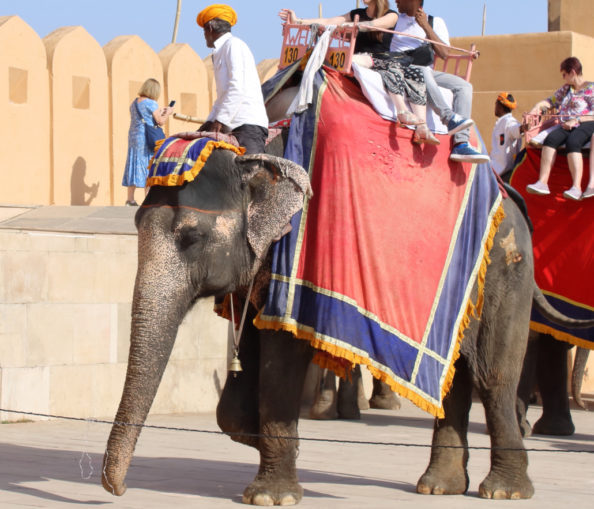
© Colin Cross, Going Postal 2022
I’d hoped to see elephants, but had decided I didn’t want to see them in an environment which wasn’t conducive to their good. The Amber Fort is reached by a long sloping causeway, which doubles back on itself several times. It was built this way as part of its defence mechanism, but for someone with a dodgy hip and a bit of intolerance to heat, especially the heat generated in a near desert mountainous area in mid morning, it was quite a challenge. I was pretty shocked to see people riding up on elephants, something which seemed cruel to me, but apparently there is now a strict regime in place, which (allegedly) puts the welfare of the animal first. No more than three people plus the Mahout can be carried at one time, up or down and the animals get regular breaks in a shaded area with plenty of water and fodder. I can see the attraction of a ride on an elephant (for some) but none of the party I was with chose to avail themselves, the hip was sore when I got back to the minibus, but I’m glad I left that particular experience to others. These were the only elephants I saw on the whole trip.
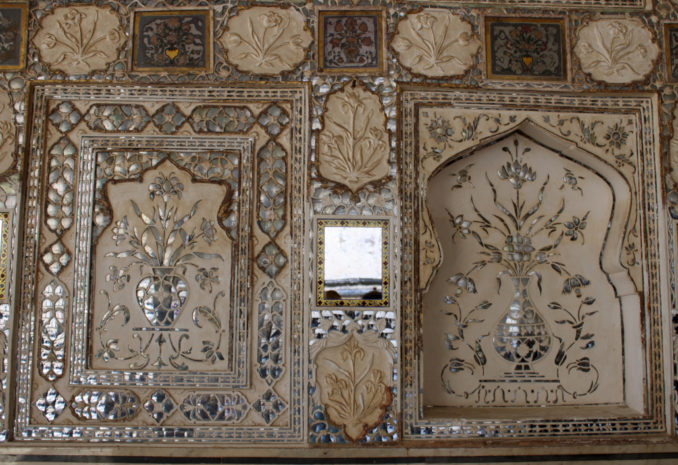
© Colin Cross, Going Postal 2022
The Mirror Palace is an artistic marvel, with artisans from Persia credited with the painstaking work of inlaying many hundreds of thousands of pieces of reflective material (glass, metal and precious stones) to create room after room of friezes, portico’s, columns and doorways. A truly amazing place.
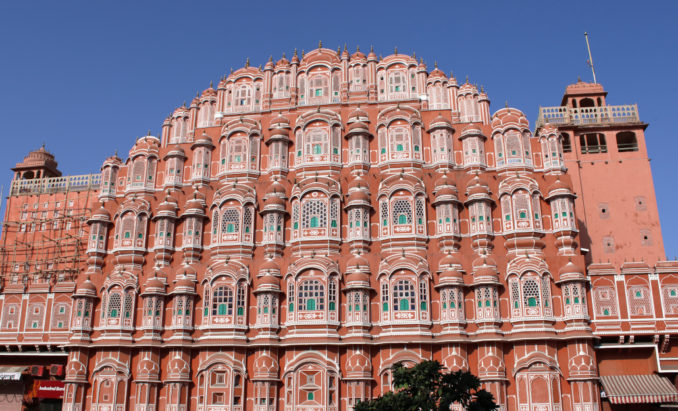
© Colin Cross, Going Postal 2022
Inside the Old City of Jaipur there are yet more sights to stir the imagination. The “Pink Palace” (Hawa Mahal) was built in 1799, on the order of Pratap Singh, a grandson of Jai Sing, the founder of Jaipur, the architect was called Lal Chand Ustad. The 953 windows look out onto what was the main thoroughfare through the city (it remains a very busy market street to this day). The windows allowed the ladies of the Royal court to observe the general day to day goings on, along with processions and festivals, without breaking the rule of “purdah”, allowing them to remove their face coverings without being seen by passers by and celebrants alike. As imposing as the facade is, the palace itself is one room wide on the top three floors, whilst the bottom two floors have rear porticoes. We took a leisurely stroll along the bustling street with its shops, street traders, food and market stalls as people went about their day to day. Westerners are, I suppose, a common sight in Jaipur, although we did illicit some mild curiosity from some people, along with the unwanted attentions of a beggar or two but we were getting used to ignoring them by this time, Delhi is a good teacher in that regard. I bought a selection of spices from a shop reputed to be one of the oldest of its kind in the city, having been run by generations of the same family for over 200 years. I’m guessing the vacuum packing machine is a fairly recent addition.
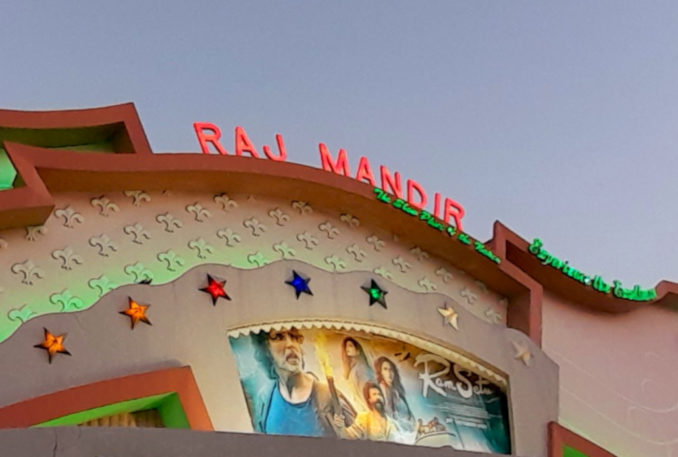
© Colin Cross, Going Postal 2022
The Raj Mandir is another special, if slightly incongruous building in Jaipur. This cinema was opened in 1976 but is built in the style of late “Art Deco”, it’s interior is opulent and, as large as it is, it always pays to book as it’s become a very popular tourist attraction for both Indian and Western tourists. The film we saw, “Ram Setu” sadly wasn’t an all singing, all dancing Bollywood romp, it was more an allegory, complete with a mythical God, for the time honoured big business versus the environment. Although in Hindi and without subtitles the greatly overacted and stylised story was easy enough to follow. Baddies and goodies are recognisable in films, whatever language the dialogue is in. A thoroughly entertaining experience, even if whole families of people traipsed to and fro during the whole performance. Indians don’t necessarily go to the cinema simply to watch a film.
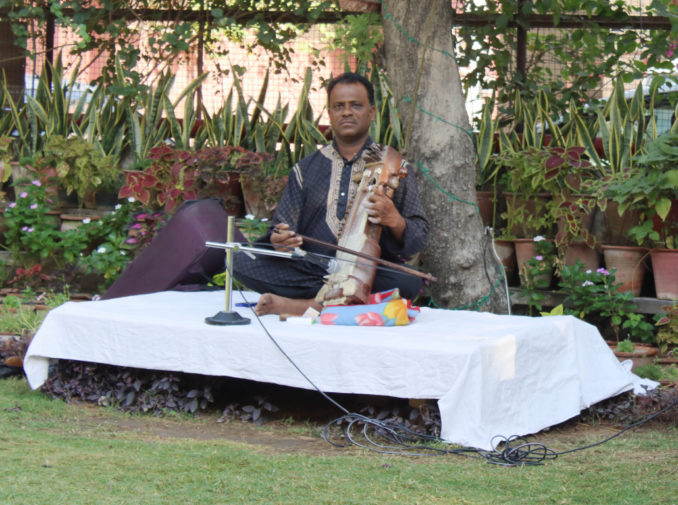
© Colin Cross, Going Postal 2022
Last morning in Jaipur and the Masala Omelette with “butter toast” remains the breakfast of choice. The music itself was “interesting”, the musician himself more so; he makes his whole living moving from hotel to hotel entertaining guests whilst they eat and drink, his mode of transport is something a Cumbrian would be proud of, a real “yawk up”. It’s a tricycle affair, with a lawn mower engine and a small fixed flatbed for his kit. Have “Sarod” will travel. Amusing to be sat on the next table to a Dutch “Hare Krishna” couple in full regalia, complete with shaven heads, little top knots and oodles of beads. They’ve obviously turned their backs on the modern, materialistic world, apart from the i-phones, air pods, smart watches and laptops. Good luck to them. I’d allowed myself to be talked into buying a pinkie ring the previous day, after purchasing a made to measure eternity ring for Mrs. F, it’s a nice little piece of jewellery, but Caveat Emptor is always sage advice, especially when on “holiday”. After breakfast we set off eastwards, towards Karauli and our final destination Agra by way of Bharatpur, more of which later.

© Colin Cross, Going Postal 2022
The drive was pretty uneventful, we travelled through a couple of those small towns previously mentioned, each one a mirror image (virtually) of the previous on. Interesting to see many scooters with very smartly and colourfully dressed female pillion passengers, some with children, all on their way to visit their brothers and the children’s uncles. Brothers and Sisters day was officially in May, so whether this was a Diwali add on, or a result of Covid restrictions, we didn’t find out. We also spotted a large herd of wild antelope (Nilgai), crossing an area of recently ploughed farmland, the only real wildlife, apart from birds, of which there are an abundance, on the whole trip. It was just getting dark when we arrived at Bhanwar Vilas. Now an Heritage hotel, it’s still occupied, in part, by the man who would have been the Raja of the area, if such things still existed. I’ve rambled on enough now, more stories from the road trip next time.
Next Time; Karauli, Bharatpur, Agra, The Taj Mahal, Delhi.
© Colin Cross 2022


